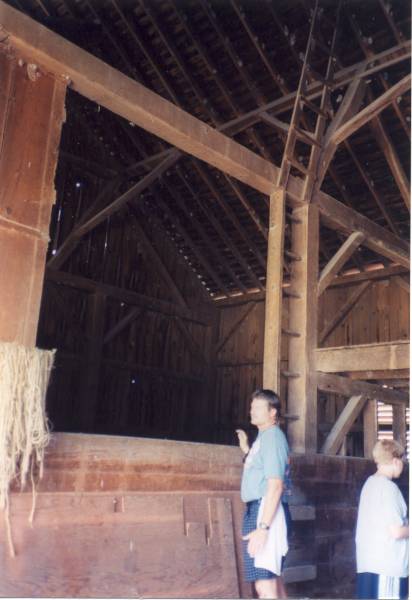| Feature Story April 2006 Barns, soon a thing of the past! …Bob Williamson |
| Many things in rural America are changing now days and sometimes, some need to be preserved! The focal point of every early farmstead was the barn. Year round it served a purpose in the lives of the livestock and farm families. The Pennsylvania Dutch had a pattern they brought west with them on barn making. Many were constructed with native timbers and wooden pegs instead of nails. Sand stone rocks were used for a foundation. When the prairie was being plowed and a homestead was being established a new barn was next to the home dwelling in order of construction. The Colony would get together and do one a year with each neighbor having his certain expertise in its development. Ken Heim writes in his biography of the two barns on his grandfather Sam Heim’s homestead. Mr. Heim remembers… “Our farm was about a mile and a half north of Dawson, Nebraska in Richardson County. It consisted of 160 acres. My Heim grandparents’ house was a big two-story house built in 1889. It was up he hill on the north side of the barns. Our house was newer but much smaller and located on the south side of the barns. It was built in 1923. There were two large barns, a beautiful Pennsylvania Dutch style horse barn close to Granddad’s house and a cattle barn closer to our house. Between the two barns were several small buildings and the windmill that kept the tank full of fresh water for the animals.” “The horse barn was an old style Pennsylvania Dutch horse barn, shuttered windows for ventilation, a cupola and all. It was the most impressive of all the building. I wonder who did the architectural designs of those old buildings. They were special. The horse barn was one of the best of that style in the enter area and was built in 1894. As shown in this picture, it had a lower ground floor for our workhorses to be housed and fed in. The lower area had dirt floors until latter when the part that we milked in was cemented. The lower floor of the main structure had limestone walls for the three outside walls and the second floor had dirt mounded up to it on the north side making a ramp so you could pull hay and grain wagons onto it with a team of horses. The fact that the north side of the lower floor had dirt mounded up to it made the area there very warm in the winter and cool in the summer. A technique used now days in building energy homes. The second floor was used to store machinery, hay and grain usually oats and wheat in the granaries. A chute from the oats granary bin on the second floor brought oats to the bottom floor to feed the horses. Oats was the main grain that was fed the horses. Sometimes we fed them corn but never wheat. Horses and cattle cannot properly digest wheat and will bloat and die. There were three haylofts (usually called haymows), one for prairie hay for the horses and the others were filled with alfalfa hay for the milk cows. One of those haylofts was the extended part shown in the second picture. There was also a repair shop located on the second floor just to the right as you entered the large door opening. The barnyard activity was centered around the windmill and water tank that held fresh water for the animals. Around 1930 a tank made of cement replaced the original wooden tank. In about 1920 Dad and Grandpa started a herd of polled Hereford range cattle that were kept in the cattle barn during stormy winter days. They were fed hay in the barn and when they could not be out in the cornfields eating corn stalks and husks because of bad weather. The cattle grazed during the summer months on a quarter section of pasture that Grandpa Heim owned about a mile to the south west of the home place. There was a spring fed creek that went through the pasture land so the cattle needed little attention all summer long. We would go count them at least once a week and see that they were okay and had a block of salt to lick. When they were calving, we would go see them two or three times a week or whenever we thought we should. Most of the calving was during the springtime when they were in barns.” Written by Kenneth Earl Heim, twin brother of Pennsylvania Colony Historical Society board member Dr. Keith Merle Heim. Kenneth passed away from a long bout with cancer a few years ago and is buried in Texas. |
